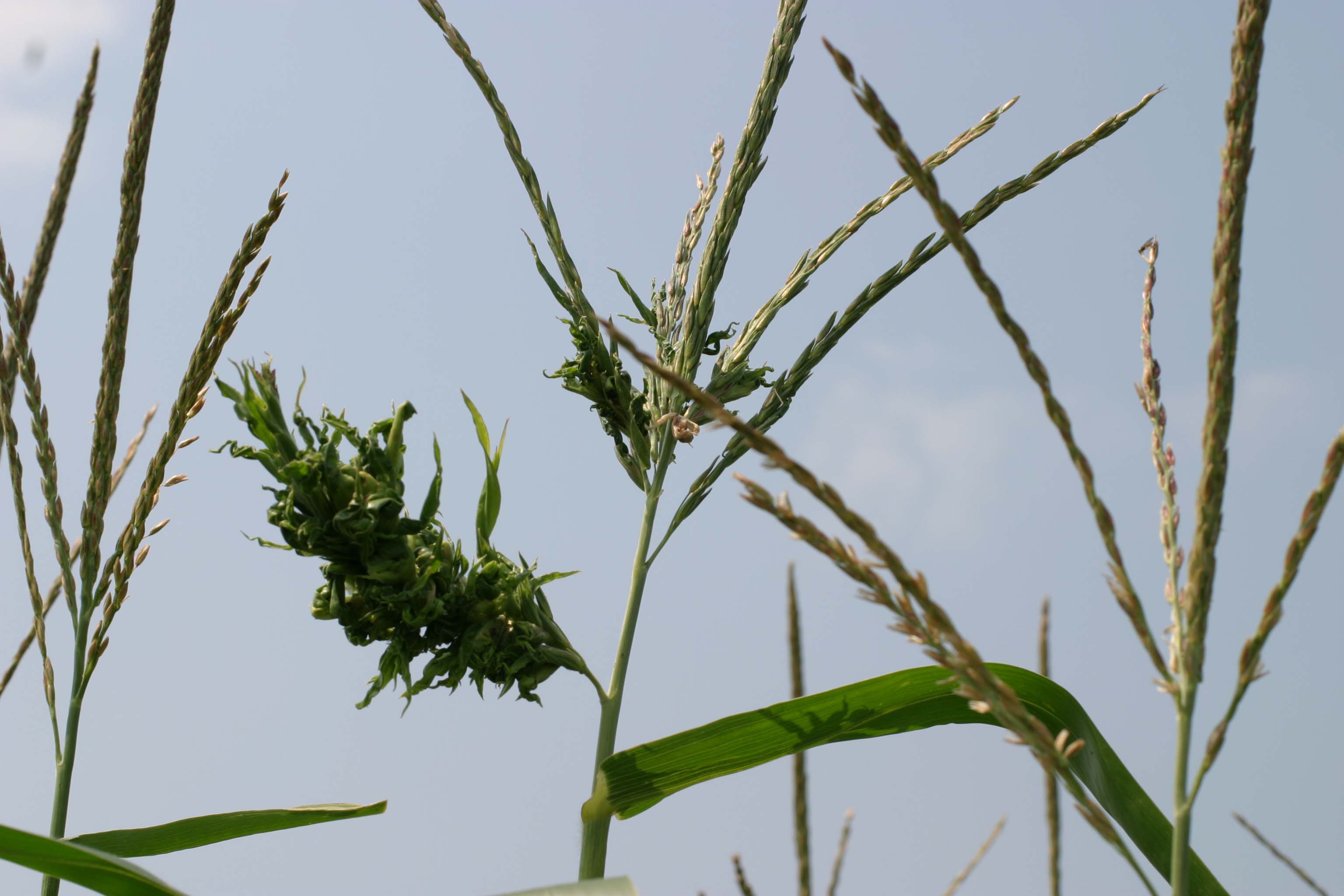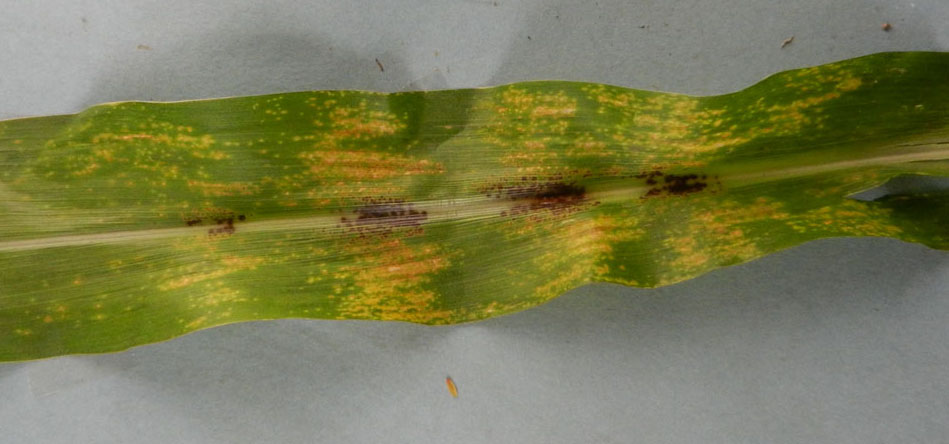
Pest & Crop
Newsletter
Purdue Cooperative Extension Service

Purdue Cooperative Extension Service
Issue 17, July 23, 2015 • USDA-NIFA Extension IPM Grant
CLICK HERE FOR A PDF VERSION OF THIS ISSUE ![]()
Heavy rain and ponding in Indiana corn fields this spring have increased the prevalence of two minor diseases of corn, crazy top and Physoderma brown spot. These diseases are rarely yield limiting, but it is important to correctly identify these diseases to prevent unwarranted management.
Crazy top is caused by a fungal-like organism called Sclerophthora macrospora. This pathogen survives in soil and infects young corn plants when there is excess rain or ponding in the spring. Crazy top symptoms are most commonly observed at tasseling when distorted and malformed tassels appear in areas that were ponded or saturated (Fig. 1). However, in some fields symptoms may be less diagnostic, and include stunting, tillering, thin, yellow leaves, and barren plants.
Physoderma brown spot is caused by the fungus Physoderma maydis, and also survives in soil and residue and infects corn plants when plants are ponded or excess water remains in the whorl. The symptoms typically appear in the late vegetative stages through pollination and are characterized by very small chocolate brown or yellow lesions on the leaves and midrib (Fig. 2). The lesions may appear in a banded pattern (Fig.3). The lesions can also be found on the stalk, leaf sheath, or ear husks.
These diseases rarely need management and are usually only problematic in wet years. Improving soil drainage and removing infected plants will reduce the disease risk for subsequent crops. Fungicides are labeled for Physoderma brown spot management, but symptoms are usually not severe enough to warrant preventative fungicide applications.
 Figure 1. Crazy top in corn. (Figure courtesy: Greg Shaner)
Figure 1. Crazy top in corn. (Figure courtesy: Greg Shaner)
 Figure 2. Symptoms of Physoderma brown spot on leaves.
Figure 2. Symptoms of Physoderma brown spot on leaves.
 Figure 3. Banding pattern of Physoderma brown spot.
Figure 3. Banding pattern of Physoderma brown spot.
Second generation European corn borer moths are becoming active throughout the state. To most corn producers, this means nothing because of the excellent protection from Bt-traited hybrids. However, there is a segment of our corn acreage, e.g., popcorn, waxy, high-oil, white, that doesn’t have “built-in” control of this and other aboveground insect pests. Youthful field personnel are no longer familiar with this former threat to corn, which hasn’t gone away! The following is a primer on scouting corn for the second generation corn borer.
Managing second generation borers is not an easy task and requires careful field inspections for egg masses and small, newly hatched larvae. For this brood, female moths are usually attracted to actively pollinating fields, often laying their eggs in the ear zone of the corn plant (90% of the time). These eggs are most often laid on the undersides of the leaves near the midrib. Once the eggs hatch, the larvae crawl toward the stalk to feed in the whorls (if still present), behind leaf sheaths, in tassels, beneath the husks around ear shanks, or in the ears. Be careful not to overlook the small larvae in leaf axils containing pollen and anthers from the tassel. The following video may help with scouting techniques.
Dynamic thresholds exist for determining treating European corn borer with the data collected from field inspections. You can find this and other information at: http://extension.entm.purdue.edu/fieldcropsipm/insects/euro-cornborer.php
If, during your inspection, you find that many of the borers have already entered the stalk, then it is too late to consider controls.
| County | Cooperator | WBC Trapped | ||||
|---|---|---|---|---|---|---|
| Week 1 6/18/15 - 6/24/15 |
Week 2 6/25/15 - 7/1/15 |
Week 3 7/2/15 - 7/8/15 |
Week 4 7/9/15 - 7/15/15 |
Week 5 7/16/15 - 7/22/15 |
||
| Adams | Kaminsky/New Era Ag | 0 | 0 | 0 | 2 | 3 |
| Adams | Roe/Mercer Landmark | 0 | 0 | 0 | 0 | 0 |
| Allen | Anderson/Syngenta Seed | 0 | 0 | 0 | 5 | 3 |
| Allen | Gynn/Southwind Farms | 0 | 0 | 1 | 2 | 12 |
| Allen | Kneubuhler/G&K Concepts | 0 | 0 | 0 | 0 | 5 |
| Bartholomew | Bush/Pioneer Hybrids | 0 | 0 | 0 | 0 | 0 |
| Boone | Campbell/Beck's Hybrids | 0 | 0 | 0 | 0 | |
| Clay | Bower/Ceres Solutions/Brazil | 0 | 0 | 0 | 0 | |
| Clay | Bower/Ceres Solutions/Bowling Green | 0 | 0 | 0 | 0 | |
| Clinton | Emanuel/Boone Co. CES | 0 | 0 | 0 | 1 | 1 |
| Clinton | Foster/Purdue Entomology | 0 | 0 | 0 | 5 | |
| DeKalb | Hoffman/ATA Solutions | 0 | 0 | 10 | 114 | |
| Dubois | Eck/Purdue CES | 0 | 0 | 0 | 0 | 1 |
| Elkhart | Kauffman/Crop Tech Inc. | 1 | 1 | 0 | 59 | 89 |
| Fayette | Schelle/Falmouth Farm Supply Inc. | 0 | 0 | 0 | 0 | |
| Fountain | Mroczkiewicz/Syngenta | 0 | 0 | 14 | 52 | 2 |
| Fulton | Jenkins/N. Central Coop-Rochester | 0 | 2 | 262 | 679 | 701 |
| Fulton | Jenkins/N. Central Coop-Kewana | 1 | 2 | 121 | 595 | 362 |
| Gibson | Schmitz/Gibson Co. CES | 0 | 0 | 0 | ||
| Hamilton | Campbell/Beck's Hybrids | 0 | 0 | 0 | 0 | |
| Hamilton | Truster/Reynolds Farm Equipment | 0 | 0 | 0 | 0 | 0 |
| Hendricks | Nicholson/Nicholson Consulting | 0 | 0 | 0 | 0 | 1 |
| Henry | Schelle/Falmouth Farm Supply Inc., Millville | 0 | 0 | 0 | 0 | |
| Jasper | Overstreet/Purdue CES | 0 | 0 | 2 | 51 | 64 |
| Jasper | Ritter/Brodbeck Seeds | 1 | 0 | |||
| Jay | Boyer/Davis PAC | 0 | 0 | 0 | 0 | 0 |
| Jay | Shrack/Ran Del Agri Services | 0 | 0 | 0 | 0 | |
| Jay | Temple/Jay County CES | 2 | 0 | |||
| Jennings | Bauerle/SEPAC | 0 | 1 | 0 | 0 | 0 |
| Knox | Bower/Ceres Solutions/Freelandville | 0 | 0 | 0 | ||
| Knox | Bower/Ceres Solutions/Vincennes | 0 | 0 | 0 | ||
| Knox | Bower/Ceres Solutions/Frichton | 0 | 0 | 0 | ||
| Lake | Kleine/Kleine Farms | 0 | 2 | 14 | 7 | |
| Lake | Moyer/Dekalb Hybrids, Shelby | 0 | 2 | 7 | 19 | 165 |
| Lake | Moyer/Dekalb Hybrids, Schneider | 1 | 0 | 4 | 67 | 456 |
| LaPorte | Rocke/Agri-Mgmt Solutions, Wanatah | 0 | 5 | 74 | 141 | 142 |
| LaPorte | Rocke/Agri-Mgmt Solutions, LaCrosse | 0 | 2 | 135 | 350 | 110 |
| Miami | Early/Pioneer Hybrids | 0 | 6 | 141 | 86 | |
| Miami | Myers/Myers Ag Service | 2 | 1 | 9 | ||
| Montgomery | Stine/Nicholson Sonsulting | 0 | 0 | 0 | 11 | |
| Newton | Moyer/Dekalb Hybrids, Lake Village | 0 | 1 | 3 | 13 | 38 |
| Porter | Leuck/PPAC | 0 | 1 | 10 | 56 | 87 |
| Putnam | Nicholson/Nicholson Consulting | 0 | 0 | 0 | ||
| Randolph | Boyer/DPAC | 0 | 0 | 0 | 2 | 0 |
| Rush | Schelle/Falmouth Farm Supply Inc. | 0 | 0 | 0 | 0
|
|
| Shelby | Simpson/Simpson Farms | 0 | 0 | 2 | 0 | |
| Sullivan | Bower/Ceres Solutions/Sullivan | 0 | 0 | 3 | ||
| Tippecanoe | Bower/Ceres Solutions | 2 | 15 | 30 | ||
| Tippecanoe | Nagel/Ceres Solutions | 0 | 0 | 0 | 1 | 0 |
| Tippecanoe | Obermeyer/Purdue Entomology | 0 | 0 | 0 | 1 | |
| Tippecanoe | Westerfeld/Monsanto | 0 | 0 | 0 | 0 | 0 |
| Whitley | Walker/NEPAC | 0 | 0 | 2 | 47 | 119 |
* = Intensive Capture...this occurs when 9 or more moths are caught over a 2-night period
Purdue Extension Entomology
901 W. State Street
West Lafayette, IN, 47907
(765) 494-8761
luck@purdue.edu
@PurdueExtEnt
PurdueEntomology

If you would like to be alerted by e-mail when the current issue of the Pest&Crop is available on-line, please enter your e-mail address and click the submit button.
It is the policy of the Purdue University Cooperative Extension Service that all persons have equal opportunity and access to its educational programs, services, activities, and facilities without regard to race, religion, color, sex, age, national origin or ancestry, marital status, parental status, sexual orientation, disability or status as a veteran. Purdue University is an Affirmative Action institution. This material may be available in alternative formats.